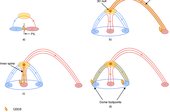 IIA JAYANT JOSHI
IIA JAYANT JOSHIMagnetic topology of quiet-Sun Ellerman bombs and associated ultraviolet brightenings
Context. Quiet-Sun Ellerman bombs (QSEBs) are small-scale magnetic reconnection events in the lower atmosphere of the quiet Sun. Recent work has shown that a small percentage of them can occur co-spatially and co-temporally with ultraviolet (UV) brightenings in the transition region.
Aims. We aim to understand how the magnetic topologies associated with closely occurring QSEBs and UV brightenings can facilitate energy transport and connect these events.
Methods. We used high-resolution Hβ observations from the Swedish 1-m Solar Telescope (SST) and detected QSEBs using k-means clustering. We obtained the magnetic field topology from potential field extrapolations using spectro-polarimetric data in the photospheric Fe I 6173 Å line. To detect UV brightenings, we used coordinated and co-aligned data from the Interface Region Imaging Spectrograph (IRIS) and imposed a threshold of 5σ above the median background on the (IRIS) 1400 Å slit-jaw image channel.
Results. We identify four distinct magnetic configurations that associate QSEBs with UV brightenings, including a simple dipole configuration and more complex fan-spine topologies with a 3D magnetic null point. In the fan-spine topology, the UV brightenings occur near the 3D null point, while QSEBs can be found close to the footpoints of the outer spine, the inner spine, and the fan surface. The height of the 3D null varies between 0.2 Mm and 2.6 Mm, depending on the magnetic field strength in the region. Some QSEBs and UV brightenings, though occurring close to each other, are not topologically connected with the same reconnection process. The energy released during QSEBs falls in the range 1023–1024 ergs.
Conclusions. This study shows that magnetic connectivity and topological features, such as 3D null points, are crucial in linking QSEBs in the lower atmosphere with UV brightenings in the transition region.
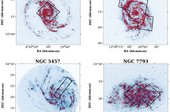 IIA SHASHANK GAIROLA
IIA SHASHANK GAIROLATracing hierarchical star formation out to kiloparsec scales in nearby spiral galaxies with UVIT
Molecular clouds fragment under the action of supersonic turbulence and gravity, which results in a scale-free hierarchical distribution of star formation within galaxies. Recent studies suggest that the hierarchical distribution of star formation in nearby galaxies shows a dependence on host galaxy properties. In this context, we study the hierarchical distribution of star formation from a few tens of parsecs up to several kiloparsecs in four nearby spiral galaxies: NGC 1566, NGC 5194, NGC 5457, and NGC 7793, by leveraging large-field-of-view and high-resolution far-ultraviolet (FUV) and near-ultraviolet (NUV) observations from the UltraViolet Imaging Telescope (UVIT). Using the two-point correlation function, we infer that the young star-forming clumps (SFCs) in the galaxies are arranged in a fractal-like hierarchical distribution, but only up to a maximum scale. This largest scale of hierarchy (lcorr) is ubiquitous in all four galaxies and ranges from 0.5 kpc to 3.1 kpc. The flocculent spiral NGC 7793 has roughly five times smaller lcorr than the other three grand design spirals, possibly due to its lower mass, lower pressure environment, and a lack of strong spiral arms. lcorr being much smaller than the galaxy size suggests that the star formation hierarchy does not extend to the full galaxy size and it is likely an effect set by multiple physical mechanisms in the galaxy. The hierarchical distribution of SFCs dissipates almost completely within 10−50 Myr in our galaxy sample, signifying the migration of SFCs away from their birthplaces with increasing age. The fractal dimension of the hierarchy for our galaxies is found to be between 1.05 and 1.50. We also find that depending upon the star formation environment, significant variations can exist in the local and global hierarchy parameters of a galaxy. Overall, our results suggest that the global hierarchical properties of star formation in galaxies are not universal. This study also demonstrates the capabilities of UVIT in characterising the star formation hierarchy in nearby galaxies. In the future, a bigger sample can be employed to better understand the role of large-scale galaxy properties such as morphology and environment as well as physical processes like feedback, turbulence, shear, and interstellar medium conditions in determining the non-universal hierarchical properties of star formation in galaxies.
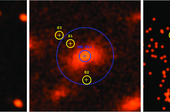 IIA MUNEER, S
IIA MUNEER, SSerendipitous detection of an intense X-ray flare in the weak-line T Tauri star KM Ori with SRG/eROSITA
Weak-line T Tauri stars (WTTS) exhibit X-ray flares, likely resulting from magnetic reconnection that heats the stellar plasma to very high temperatures. These flares are difficult to identify through targeted observations. Here, we report the serendipitous detection of the brightest X-ray flaring state of the WTTS KM Ori in the eROSITA DR1 survey. Observations from SRG/eROSITA, Chandra Xray Observatory, and XMM-Newton are analysed to assess the X-ray properties of KM Ori, thereby establishing its flaring state at the eROSITA epoch. The long-term (1999–2020) X-ray light curve generated for the Chandra observations confirmed that eROSITA captured the source at its highest X-ray flaring state recorded to date. Multi-instrument observations support the X-ray flaring state of the source, with time-averaged X-ray luminosity (L0.2−5 keV) reaching ∼ 1.9 × 1032erg s−1 at the eROSITA epoch, marking it the brightest and possibly the longest flare observed so far. Such intense X-ray flares have been detected only in a few WTTS. The X-ray spectral analysis unveils the presence of multiple thermal plasma components at all epochs. The notably high luminosity (L0.5−8 keV ∼ 1032 erg s−1), energy (E0.5−8 keV ∼ 1037 erg), and the elevated emission measures of the thermal components in the eROSITA epoch indicate a superflare/megaflare state of KM Ori. Additionally, the Hα line equivalent width of ∼−5 Å from our optical spectral analysis, combined with the lack of infrared excess in the spectral energy distribution, were used to re-confirm the WTTS (thin disc/disc-less) classification of the source. The long-duration flare of KM Ori observed by eROSITA indicates the possibility of a slow-rise top-flat flare. The detection demonstrates the potential of eROSITA to uncover such rare, transient events, thereby providing new insights into the X-ray activity of WTTS
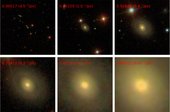 IIA SUDHANSHU BARWAY
IIA SUDHANSHU BARWAYAutomated detection of galactic rings from sloan digital sky survey images
Morphological features in galaxies—like spiral arms, bars, rings, and tidal tails, etc.—carry information about their structure, origin, and evolution. It is therefore important to catalog and study such features and to correlate them with other basic galaxy properties, the environments in which the galaxies are located, and their interactions with other galaxies. The volume of present and future data on galaxies is so large that traditional methods, which involve expert astronomers identifying morphological features through visual inspection, are no longer sufficient. It is therefore necessary to use AI-based techniques like machine learning and deep learning to find morphological structures quickly and efficiently. We report in this study the application of deep learning for finding ring-like structures in galaxy images from the Sloan Digital Sky Survey (SDSS) DR18. We use a catalog by R. J. Buta of ringed galaxies from SDSS to train the network, reaching good accuracy and recall, and generate a catalog of 29,420 galaxies, of which 4855 have ring-like structures with prediction confidence exceeding 90%. Using a catalog of barred galaxy images identified by S. Abraham et. al. with deep-learning techniques, we identify a set of 2087 galaxies with bars as well as rings. The catalog should be very useful in understanding the origin of these important morphological structures. As an example of the usefulness of the catalog, we explore the environments and star formation characteristics of the ring galaxies in our sample.
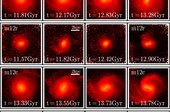 IIA SIOREE ANSAR
IIA SIOREE ANSARBar formation and destruction in the FIRE-2 simulations
The physical mechanisms responsible for bar formation and destruction in galaxies remain a subject of debate. While we have gained valuable insight into how bars form and evolve from isolated idealized simulations, in the cosmological domain, galactic bars evolve in complex environments, with mergers and gas accretion events occurring in the presence of the turbulent interstellar medium with multiple star formation episodes, in addition to coupling with their host galaxies' dark matter halos. We investigate the bar formation in 13 Milky Way–mass galaxies from the Feedback in Realistic Environments (FIRE-2) cosmological zoom-in simulations. 8 of the 13 simulated galaxies form bars at some point during their history: three from tidal interactions and five from internal evolution of the disk. The bars in FIRE-2 are generally shorter than the corotation radius (mean bar radius ∼1.53 kpc), have a wide range of pattern speeds (36–97 km s‑1 kpc‑1), and live for a wide range of dynamical times (2–160 bar rotations). We find that the bar formation in FIRE-2 galaxies is influenced by satellite interactions and the stellar-to-dark-matter mass ratio in the inner galaxy, but neither is a sufficient condition for bar formation. Bar formation is more likely to occur, with the bars formed being stronger and longer-lived, if the disks are kinematically cold; galaxies with high central gas fractions and/or vigorous star formation, on the other hand, tend to form weaker bars. In the case of the FIRE-2 galaxies, these properties combine to produce ellipsoidal bars with strengths A 2/A 0 ∼ 0.1–0.2 .
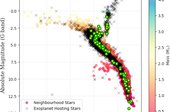 IIA RAVINDER K. BANYAL
IIA RAVINDER K. BANYALThe 10 pc Neighborhood of Habitable Zone Exoplanetary Systems: Threat Assessment from Stellar Encounters and Supernovae
The habitability of a planet is influenced by both its parent star and the properties of its local stellar neighborhood. Potential threats to habitability from the local stellar environment mainly arise from two factors: cataclysmic events such as powerful stellar explosions and orbital perturbations induced by close stellar encounters. Among the 4500+ exoplanet-hosting stars, about 140+ are known to host planets in their habitable zones (HZs). In this study, we use Gaia Data Release 3 data to investigate the 10 pc stellar neighborhood of the 84 habitable zone systems (HZSs) closest to the Sun. We assess the possible risks that the local stellar environments of these HZSs pose to their habitability. In particular, we find that HD 165155 has a high stellar density around it, making it likely to experience at least one flyby encounter within a span of 5 Gyr. We also identified two high-mass stars (M ≥ 8 M ⊙) as potential progenitors of supernovae, which could threaten the long-term survivability of HZSs HD 48265 and TOI-1227. Further, to quantify the similarity between HZ stars and the Sun, as well as their respective 10 pc stellar environments, we employ various astrophysical parameters to define a solar similarity index and a neighborhood similarity index. Our analysis suggests that HD 40307 exhibits the closest resemblance to the solar system, while HD 165155 shows the least resemblance.
 IIA ARCHANA SOAM
IIA ARCHANA SOAMA compilation of optical starlight polarization catalogs
Polarimetry of stars at optical and near-infrared wavelengths is an invaluable tool for tracing interstellar dust and magnetic fields. Recent studies have demonstrated the power of combining stellar polarimetry with distances from the Gaia mission, in order to gain accurate, 3D information on the properties of the interstellar magnetic field and the dust distribution. However, access to optical polarization data is limited, as observations are conducted by different investigators, with different instruments, and are made available in many separate publications. To enable a more widespread accessibility of optical polarimetry for studies of the interstellar medium, we compile a new catalog of stellar polarization measurements. The data are gathered from 81 separate publications spanning two decades since the previous, widely used agglomeration of catalogs by C. Heiles. The compilation contains a total of 55,742 measurements of stellar polarization. We combine this database with stellar distances based on the Gaia Early Data Release 3, thereby providing polarization and distance data for 42,482 unique stars. We provide two separate data products: an extended catalog (containing all polarization measurements) and a unique source catalog (containing a subset of sources excluding duplicate measurements). We propose the use of a common tabular format for the publication of stellar polarization catalogs to facilitate accessibility and increase discoverability in the future
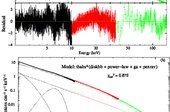 IIA SANTANU MONDAL
IIA SANTANU MONDALInsight-HXMT View of the Black Hole Candidate Swift J1727.8–1613 during Its Outburst in 2023
The transient Galactic black hole candidate Swift J1727.8-1613 went through an outburst for the very first time in 2023 August and lasted for almost 6 months. We study the timing and spectral properties of this source using publicly available archival Insight-HXMT data for the first 10 observation IDs that last from MJD 60181 to 60198 with a total of 92 exposures for each of the three energy bands. We have detected quasi-periodic oscillations (QPOs) in a frequency range of 0.21 ± 0.01–1.86 ± 0.01 Hz by fitting the power density spectrum. Based on the model-fitted parameters and properties of the QPOs, we classify them as type C in nature. We also conclude that the origin of the QPOs could be the shock instabilities in the transonic advective accretion flows around black holes. The spectral analysis was performed using simultaneous data from the three onboard instruments LE, ME, and HE of Insight-HXMT in the broad energy band of 2‑150 keV. To achieve the best fit, spectral fitting required a combination of models, e.g., interstellar absorption, power-law, multicolor disk–blackbody continuum, Gaussian emission/absorption, and reflection by neutral material. From the spectral properties, we found that the source was in an intermediate state at the start of the analysis period and was transitioning to the softer states. The inner edge of the accretion disk moved inward in progressive days following the spectral nature. We found that the source has a high inclination of 78°‑86°. The hydrogen column density from the model fitting varied in the range of (0.12 ± 0.02‑0.39 ± 0.08) × 1022 cm‑2.
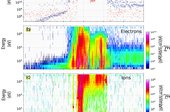 IIA WAGEESH MISHRA
IIA WAGEESH MISHRALow-latitude Auroras: Insights from 2023 April 23 Solar Storm
In 2023 April, a low-latitude aurora observed by the all-sky camera at Hanle, Ladakh, India (33°14'N geographic latitude), generated significant interest. This was the first such aurora recorded from the Indian region in the space era and occurred during a moderate solar storm. This study explores this low-latitude auroral sighting, which happened during the sheath-region passage of an interplanetary coronal mass ejection. We analyze in situ multispacecraft particle measurements and geomagnetic field observations from both ground-based and satellite-based magnetometers. The auroral observations at Hanle coincided with intense substorm activity. Our findings indicate that the aurora did not actually reach India; the equatorward boundary was beyond 50°N geographic latitude. Enhanced electron fluxes with energies below 100 eV were detected at 54°N geographic latitude at about 830 km altitude in the predawn sector (4–5 hr local time). In the midnight sector, the equatorward boundary is estimated to be around 52°N geographic latitude, based on Hanle observations and considering emission altitudes of 600–650 km due to low-energy electrons. Thus, the low-latitude red aurora observed from India resulted from the emissions at higher altitudes due to low-energy electron precipitation in the auroral oval and a slight equatorward expansion of the auroral oval. The low-energy electrons likely originated from the plasma sheet and were precipitated due to enhanced wave–particle interactions from strong magnetosphere compression during high solar wind pressure. This study is crucial in understanding low-latitude auroras in the modern space era.
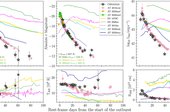 IIA MRIDWEEKA SINGH
IIA MRIDWEEKA SINGHCSS 161010: A luminous fast blue optical transient with broad blueshifted hydrogen lines
We present ultraviolet, optical, and near-infrared photometric and optical spectroscopic observations of the luminous fast blue optical transient (LFBOT) CSS 161010:045834–081803 (CSS 161010). The transient was found in a low-redshift (z = 0.033) dwarf galaxy. The light curves of CSS 161010 are characterized by an extremely fast evolution and blue colors. The V-band light curve shows that CSS 161010 reaches an absolute peak of mag in 3.8 days from the start of the outburst. After maximum, CSS 161010 follows a power-law decline ∝t ‑2.8±0.1 in all optical bands. These photometric properties are comparable to those of well-observed LFBOTs such as AT 2018cow, AT 2020mrf, and AT 2020xnd. However, unlike these objects, the spectra of CSS 161010 show a remarkable transformation from a blue and featureless continuum to spectra dominated by very broad, entirely blueshifted hydrogen emission lines with velocities of up to 10% of the speed of light. The persistent blueshifted emission and the lack of any emission at the rest wavelength of CSS 161010 are unique features not seen in any transient before CSS 161010. The combined observational properties of CSS 161010 and its M * ∼ 108 M ⊙ dwarf galaxy host favor the tidal disruption of a star by an intermediate-mass black hole as its origin.